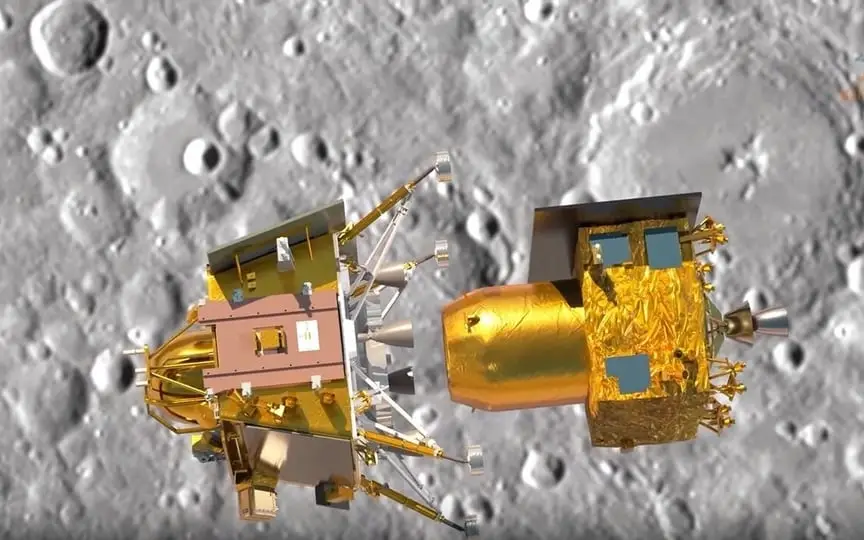Exploring Technology Used in India’s Historic Chandrayaan-3 Lunar Mission
Following the unsuccessful Luna-25 mission by Russia, all attention is now focused on the Chandrayaan-3 spacecraft by the Indian Space Research Organization (ISRO). Tomorrow, on August 23, India’s third space mission is scheduled to touch down on the lunar South Pole, and if successful, India will join the USA, China, and Russia as the fourth nation to achieve this feat. The Chandrayaan-3 is equipped with cutting-edge technology that enables the spacecraft to travel to the moon and safely land on its surface. The success of the entire mission, including spaceflight, landing, operations, and experiments, relies heavily on the advanced technology incorporated into the propulsion module, lander, and rover of the Chandrayaan-3. Here is a comprehensive overview of the technology employed in these components.
Chandrayaan-3: Components
Chandrayaan-3 has three parts – Lander (Vikram), Rover (Pragyan) and Propulsion Module. The lander and rover separated from the propulsion module on August 17 and began their descent towards the lunar surface. Meanwhile, the propulsion module remains in orbit for months and years, performing its series of tests.
Propulsion module
According to ISRO’s mission page, the Chandrayaan-3 propulsion module will carry spectropolarimetry of the SHAPE payload of a habitable planet. As the propulsion module remains in orbit for some time, the payload will perform a series of experiments, such as measurements of polarization variations in Earth’s clouds, spectroscopic analysis of Earth’s atmosphere, and collecting signatures of the exoplanet that indicate its habitability. The propulsion module is powered by a 440N liquid motor with a star detector, TTC antenna and solar panel to help it on its way.
Vikram descender
The Vikram lander will make a soft landing on August 23 and conduct experiments on the lunar surface for 14 days. It carries the RAMBHA (Radio Anatomy of Moon Bound Hypersensitive ionosphere and Atmosphere) payload. According to ISRO, the experiments include Chandra’s Surface Thermophysical Experiment (ChaSTE) to measure thermal conductivity and temperature, and the Instrument for Lunar Seismic Activity (ILSA) to measure seismic activity around the lunar south pole landing zone. In addition, its Langmuir Probe (LP) enables estimation and measurement of plasma density. The Vikram lander will also conduct laser ranging surveys of the moon using the passive Laser Retroreflector Array system courtesy of NASA.
To successfully achieve all mission objectives, the lander is equipped with a series of technical devices such as Ka-Band Altimeter (KaRA), Laser Altimeter (LASA), Laser Doppler Velocimeter (LDV), Laser Inertia Referencing and Accelerometer Package (LIRAP), Lander Position Detection Camera (LPDC) , Lander Hazard Detection and Avoidance Camera (LHDAC), Lander Horizontal Velocity Camera (LHVC) and touch sensors, inclinometer and micro star detector.
Pragya’s Rover
The lunar rover, called the Pragyan rover, will also conduct analyzes of the landing site. It is equipped with an alpha particle X-ray spectrometer (APXS) and a laser induced breakdown spectroscope (LIBS). According to ISRO, LIBS enables the rover to perform qualitative and quantitative elemental analysis of the landing site. In addition, it will further improve our understanding of the lunar surface by studying the chemical and mineralogical composition in the vicinity of the landing site. The APXS instrument allows the rover to study the lunar soil and rocks near the landing site and determine their elemental composition.
For navigation, Pragyan Rover has navigation cameras and Rx/Tx antennas. It also has wheel drive, a differential and solar panels to enable orbiting on the lunar surface.
Chandrayaan-3 is expected to land on the Moon’s south pole on August 3 at 6:04 PM IST. Be sure to check out the live coverage of India’s historic Moon mission.




